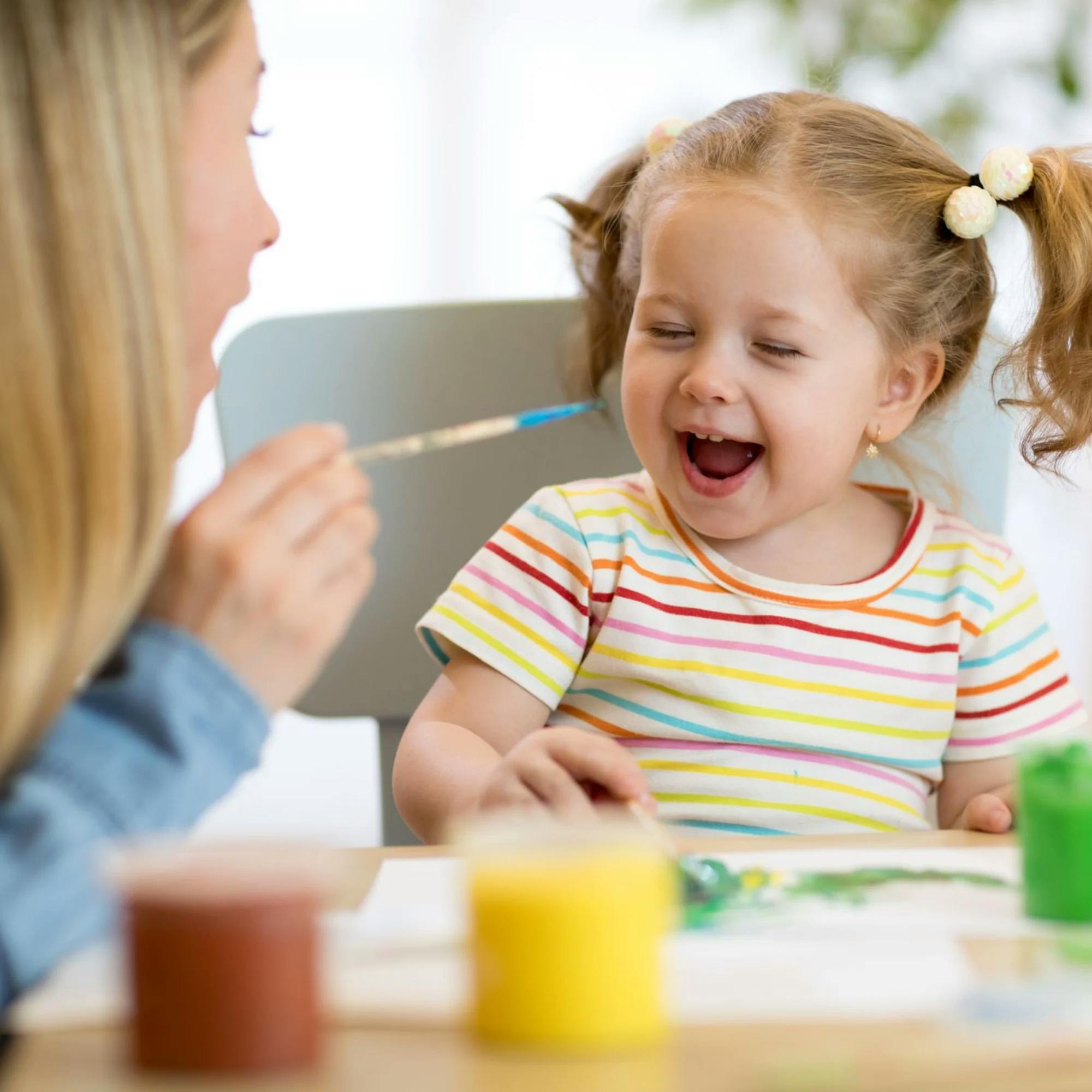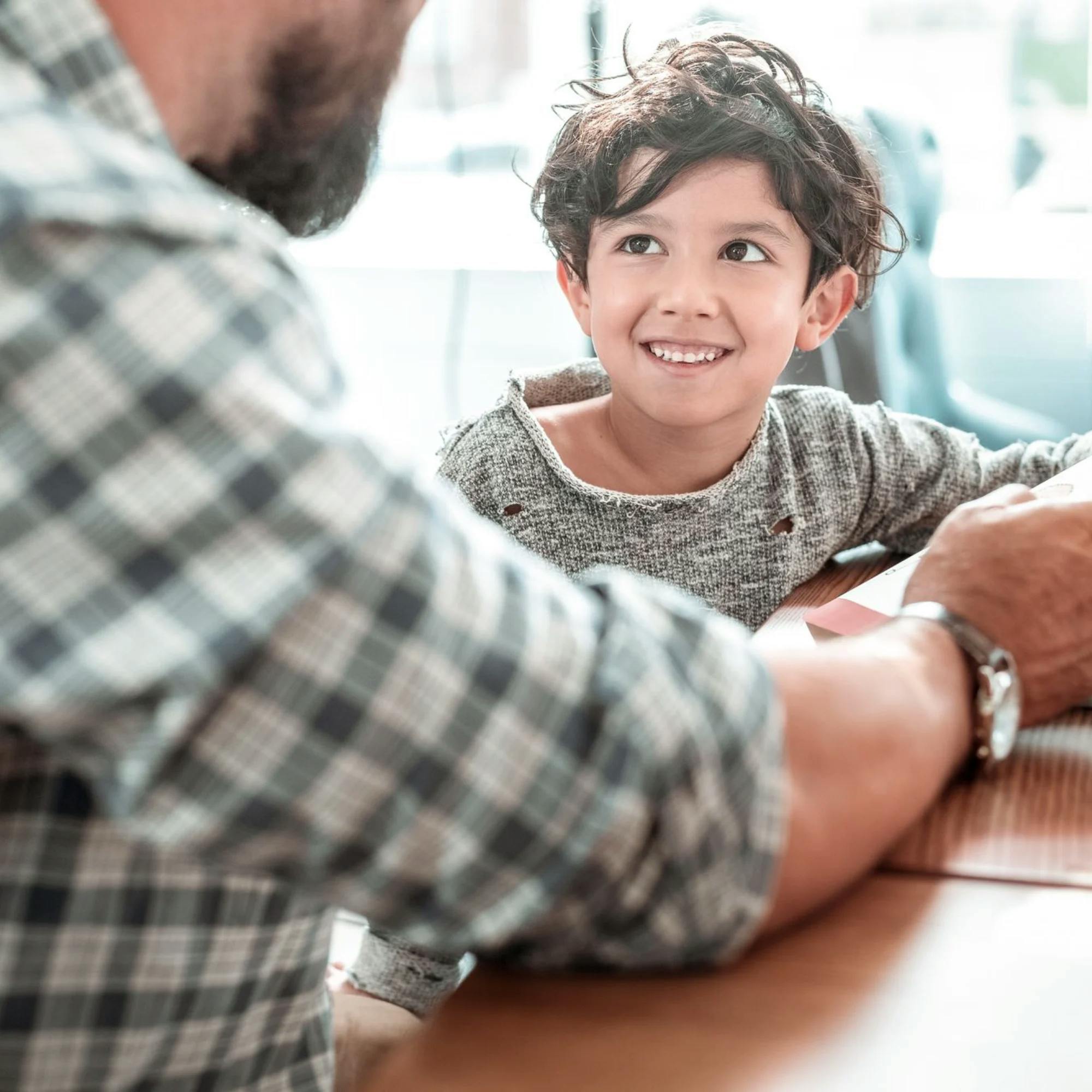
Teaching Children the /r/ Sound: What You Need to Know
 Abby Barnes, M.S., CCC-SLP
Abby Barnes, M.S., CCC-SLP
The /r/ sound is one of the most common speech errors that children experience as they develop their communication skills.
Frustratingly, it's also one of the hardest sounds to teach kiddos--and for them to learn and master! If you've ever tried to practice the /r/ sound with your child, you probably already know this.
However, with enough guidance, practice, and repetition, you can absolutely set your child up for communication success. In this article, we'll answer some of the most common questions about the /r/ sound. We'll also share impactful strategies to help your child perfect this pesky sound!
Looking for a speech therapist?
Teletherapy makes it easy. We serve families with a range of speech, language, and feeding needs across the U.S. Get started today!
 Find a speech therapist
Find a speech therapistWhy is producing the /r/ sound so difficult?
Mastering the /r/ sound can be challenging for a few reasons.
First off, there's vowel placement. The /r/ sound can precede a vowel (prevocalic) or follow a vowel (vocalic). Depending on the vowel, this can affect the pronunciation of the /r/ sound. Different vocalic combinations include “ar,” “air,” “ear,” “er,” “or,” and “ire.” Try saying each of these out loud to yourself, and you'll quickly realize all the different variations!
Throw in the fact that most of these vowel combinations can be placed within different positions of a word, and you've got a whole new level of challenge for little ones! Depending on whether the /r/ sound comes in the beginning, middle, or final position of the word can affect how it's produced.
The /r/ sound can be challenging because it's produced solely by tongue position.
Another reason the /r/ sound can be so challenging is because it's produced solely by the tongue position, making it much harder to visualize compared to other sounds. For example, with the /b/ sound, you can easily see how the lips move during production. A /th/ sound is also easily visualized: The tongue rests between the teeth. For an /r/ production, the tongue has to move in a very specific way, which can often be difficult to demonstrate to a child. Enough tongue tension is also needed in order to establish the correct tongue position required for an /r/ sound.
In summary, the /r/ sound has more variations than just about any other sound in the English language. But don't let this be discouraging! It simply requires specific techniques to teach the /r/ sound, with lots of intentional practice, which we'll cover below.
At what age should a child correctly say the /r/ sound?
While children develop various sounds at different ages, each sound in the English language does have an expected age of acquisition.
In general, the /r/ sound should be correctly produced in a child’s daily conversational speech by age 5. Use the start of kindergarten as a good rule of thumb: Children should be easily understood by others and able to say all speech sounds when they begin school.
Keep in mind that this doesn't mean you should wait until this age to begin practicing their productions. The earlier you can intervene in your child's speech and language development, the more progress they'll make.
What's important is that you're hearing speech improvements over time. If their speech seems to be progressing normally, that's a great sign! However, if their /r/ sound productions have hit a plateau, and you're not noticing improvements as they near their fifth birthday, it may be time to speak with a speech therapist and determine if intervention is warranted.
Dacarri's story
Follow along on the journey of a preteen boy working on articulation for clearer speech. "Now I have more confidence in how I sound."
 Read Dacarri's story
Read Dacarri's storyWhat are the different types of /r/ sounds?
When discussing /r/ production, it's important to identify where the /r/ sound is located in relation to a vowel or word. Children may struggle with one or more of these positions.
A prevocalic /r/ means that the /r/ comes before the vowel. These are words such as:
read
rain
right
A vocalic /r/ follows a vowel. Vocalic /r/ sounds are the following:
“ar” as in star
“air” as in hair
“ear” as in hearing
“er” as in sister
“or” as in pour
“ire” as in tired
The /r/ is produced the same way for prevocalic or vocalic. The difference with the vocalic /r/ is that the tongue has to move to the correct tongue position immediately following the vowel, with the /r/ produced as the tongue is moving to that position. Try it yourself, paying close attention to your tongue position and movement. You'll quickly realize why this can be challenging for little ones to coordinate!


How children learn the /r/ sound
There is a certain progression of complexity levels that a speech therapist will use to help children master any new speech sound. Let’s review the typical progression of the /r/ sound.
Isolation level: Saying the sound by itself
Syllable level: Combining the sound with a vowel (re, ray, rye, ro, rue)
Word level: Using the sound within a word (run, berry, winter)
Phrase level: Stringing several /r/ words together into a short two- or three-word phrase (run fast or car ride)
Sentence level: Saying longer, more complex sentences that include /r/ words (The dog runs fast)
Conversation level: The ability to use /r/ words in connected speech in conversation, 100% accurately
As a child moves through these stages, the speech therapist will help your child practice a variety of words that contain /r/ in different positions. For example, they'll use words that have an /r/ in the beginning, middle, and final positions of a word, along with words that contain the /r/ sound before and after different vowels (prevocalic vs. vocalic).
Some children go through all these levels and variations of /r/ production quickly, while others may get “stuck” at one or more of these levels, including various prevocalic or vocalic /r/ variations.
What are common /r/ sound speech errors?
There are a couple different errors that you may hear a child produce when attempting to say the /r/ sound.
A /w/ sound is often substituted for the /r/ sound. For example, the word "rice" can be pronounced as “wice.” Or you may hear a word like "berry" said as “be-wy.”
For words that end with a vocalic /r/ sound, you are likely to hear a distorted attempt at /r/. For example, the word "father" may sound like “fath-uh.” Or the word "chair" may be pronounced as “chay-uh.”
Knowing what types of errors to listen for can help caregivers spot any possible /r/ production issues in their child’s speech.
Concerned about your child's speech?
We're here for you. Get matched with a speech therapist who's experienced in your child's area of need and available when you are.
 Find a speech therapist
Find a speech therapistWhat are the different /r/ sound tongue positions?
There are two different tongue positions that can be used when saying the /r/ sound. They are referred to as "bunched position" and "retroflexed position."
Bunched tongue position: For a bunched tongue position, the tongue is--you guessed it--essentially bunched. It stays in a neutral position in the mouth. Speech therapists will often tell kiddos to “scoot your tongue back!” in their mouth.
Retroflexed position: For a retroflexed tongue position, the tip of the tongue curls and points backward toward the back of the throat.
Both of these tongue positions can be used to say a correct /r/ sound, but often one position comes more naturally for a child than another. Whichever tongue position is easiest for a child to say, and yields a correct /r/ sound, is the one that should be implemented! It may take a little bit of time and practice to determine which is best for your child.
Your speech therapist will likely also discuss tongue tension. The tongue is a muscle, and it should be high and “tight” enough in the mouth that the correct /r/ sound can be formed. A tongue that is too low in the mouth or not tight enough can make the /r/ sound like /uh/.
Is my child ready to start practicing the /r/ sound?
There are a few ways to determine if a child is ready to practice the /r/ sound.
Can they imitate the sound? One way to tell if a child's ready is to establish whether they can accurately imitate /r/ in isolation (saying the sound by itself), even if it requires a little extra help. If a child requires frequent cueing or modeling, they may not yet be ready to practice.
Can they tell the difference between correct and incorrect pronunciation? Another helpful criteria is whether a child can discriminate between a correct /r/ and incorrect /r/ sound. To test this out with your child, say both pronunciations out loud. Can they spot the right sound from the wrong one? If not, then it's important to help them identify accurate sounds first before starting sound production practice.
How old are they? With all this said, age is still an important consideration. If they're approaching age 5 and still struggling to produce the /r/ sound in isolation, it may be time to get a jumpstart on practice. A speech therapist can help assess your child's readiness and skill level to make this determination.


Tips and techniques for practicing the /r/ sound
When practicing the /r/ sound with your child, try these helpful hints!
Identify if the bunched or retroflexed tongue position is best for your child. Choose whichever position yields a correct production and is easiest for your child.
Use a mirror to help your child watch for correct lip and tongue position.
Use a visual to better explain tongue position, such as demonstrating with your hand to show the shape of the tongue, or making your own visual of the tongue shape (Play-Doh works great!). You can also try to model the /r/ tongue position for your child, opening your mouth slightly and pointing.
If the /r/ sound doesn't sound right even with frequent practice, remind your child to keep their tongue “tight.” This helps reinforce the importance of tongue tension, which is essential for correct production.
Also remind your child to keep their tongue held high enough in their mouth. One tip is to make sure the back side of their tongue is touching the inside of their top back molars. Here’s a tip for this: Try brushing the back sides of your child’s tongue with something with a flavor they like--maybe a lollipop! Explain that this is the portion of the tongue that should be touching the top back molars. This can help your child visualize their tongue placement.
Practice consistently! Daily practice is best. Aim for 10 minutes of practice every day, if possible.
Remember to stay at the stage you're currently targeting until your child is at least 90% accurate and independent. Then you can move on to the next, more complex level.
Speech exercises for the /r/ sound
Here are some helpful and fun exercises to teach your child the /r/ sound!
Make model tongues out of Play-Doh and position them in the bunched or retroflexed position--whichever position your child has been practicing. This can be super helpful for visual learners
Discuss with your child how the tongue is a muscle, and that the tongue has to be “tight and strong.” You can have your child practice closing their fists “tight” or making their arm muscles “tight.” Practicing how to elicit tension in other activities can help children better understand how it applies to speech.
Say the /r/ sound correct and incorrectly, and have your child spot the difference. Turn this into a game with a reward if they choose the right one!
As you read books with your child, have your child point out each /r/ sound that they read or hear you say.
Practice target /r/ sounds while playing a turn-taking game that your child enjoys. For example, if your child loves playing Connect 4, before each turn have them practice the /r/ sound at least three times.
Look through magazines with your child and have them find any pictures of items that use their target /r/ sound. You or your child can cut out the pictures and make a collage or picture together.
Making /r/ sound practice part of your everyday routine
The ultimate goal of all speech practice is to have children carry over their newfound skills into daily life. This means your everyday conversations can actually be powerful learning moments! Here's how.
Make sure to pick a time of day when your child is most talkative. Let your child know that you are going to be listening for correct /r/ sound productions as you talk together. Then, spend about 10 minutes talking together--doesn't matter the topic!
If you hear your child mispronounce the /r/ sound, give them the opportunity to identify the mistake themselves. If that doesn't work, gently let them know. You can verbally tell them, or give them a slight visual cue such as raising your hand. Afterward, have your child revisit that point in the conversation and retry saying the word or sentence with the correct /r/ sound.
As your child improves, they should become more independent in their ability to self-correct their productions. Continue to provide support for your child until they are fully independent and able to have fluent conversations.


What to expect during speech therapy for the /r/ sound
If you think your child might benefit from speech therapy for the /r/ sound, contact a speech-language pathologist. They'll begin by conducting a formal evaluation. This evaluation allows the speech therapist to identify which types of /r/ sounds your child is struggling with, and whether other speech sounds also require treatment. Therapy goals will be developed based on the evaluation.
During each session, the speech therapist will work on these specific goals with the child. They'll use different games and activities that the child enjoys in order to elicit frequent practice of the /r/ sound. The speech therapist will also provide recommended home practice that the caregiver and child can work on throughout the week. The more opportunities for practice and repetition a child receives throughout the week, the faster they'll reach their communication goals and master the /r/ sound at the conversation level.


What are /r/ sound speech therapy goals?
Therapy goals for /r/ production are determined by a speech-language pathologist and tailored specifically for each individual child. There are several factors that go into determining these goals:
An /r/ speech therapy goal will often be specific to what type of /r/ production is being targeted. As discussed, this will include whether the child is struggling with their /r/ sounds in the beginning, middle, or final positions of words, and whether they're having trouble with prevocalic or vocalic productions.
A therapy goal for /r/ production will also specify if the child should be producing the sound at the word level, the phrase level, the sentence level, etc.
The goal will provide a specific percentage of accuracy expected.
Let’s review one example of a possible /r/ speech therapy goal:
In the next 2-3 months, the client will demonstrate the ability to independently produce initial /r/ production with 90% accuracy across 3 consecutive sessions.
As you can see, these goals are written to be specific and measurable, so the speech therapist can track progress week over week. This also helps them know what therapy activities are most helpful for the child, and when it's appropriate to decrease the amount of cueing being provided.
How long does it take to correct the /r/ sound?
The amount of time required to correct /r/ productions will vary for each child. Some factors that contribute to the ultimate length of therapy include:
The child’s age
How quickly the child is able to learn the basic /r/ production at the isolation level
How many different types of /r/ sounds the child struggles with
The child’s motivation to improve their /r/ productions
Frequency of home practice
While the /r/ sound can be a challenging one, with speech therapy support and lots of play-based practice at home, your child can master it!
How Expressable Can Help
Concerned your child isn't reaching age-expected milestones? Looking for communication support from a professional? Expressable is a national online speech therapy practice serving children and adults. We treat all major areas of communication and feeding, offer flexible hours including evenings and weekends, and accept most major health insurance plans. We’re proud to have earned more than 3,000 5-star reviews from our clients (4.9/5 average).
Our therapy model is centered on parent and caregiver involvement. Research proves that empowering caregivers to participate in their loved one’s therapy leads to better outcomes. That’s why we combine live, 1-on-1 speech therapy with personalized education and home practice activities for faster progress.
Communication is more than words. It’s how we share how we feel and show who we are. We’re here to help you or your child do just that.






